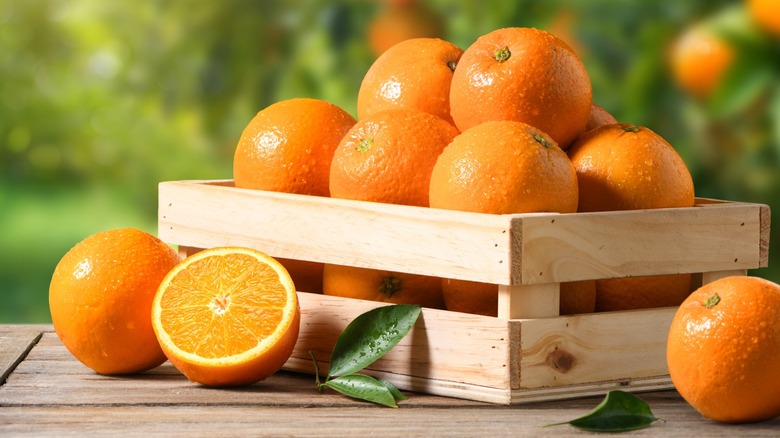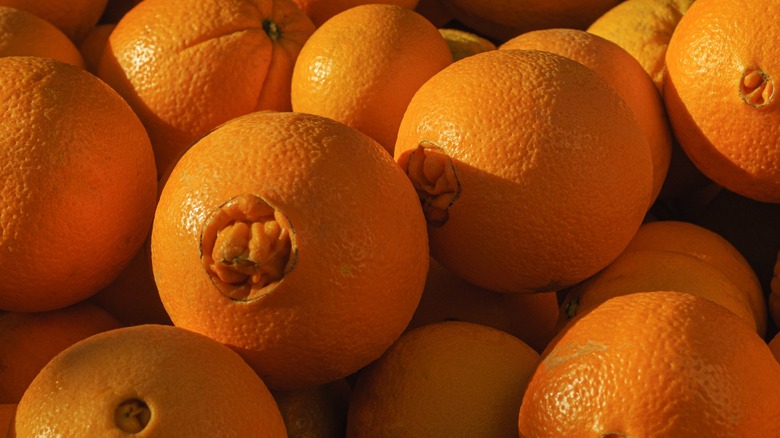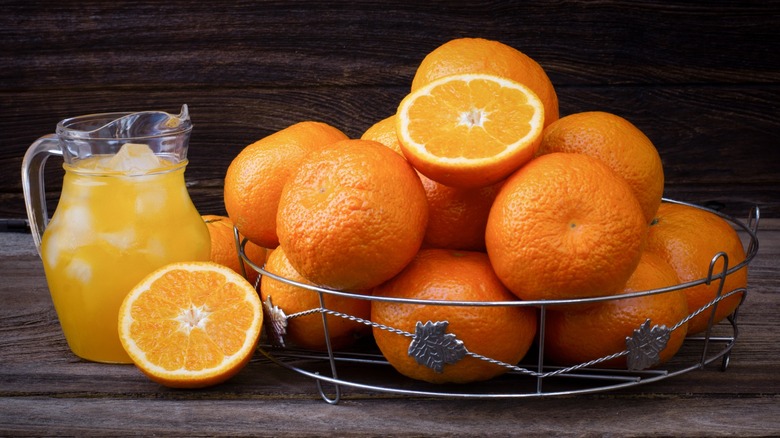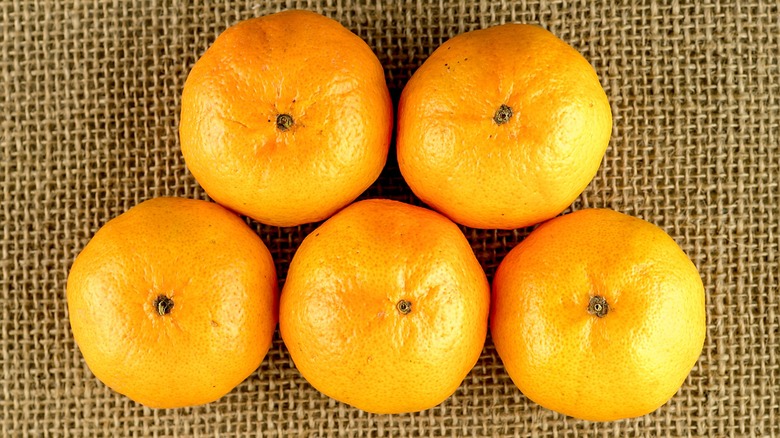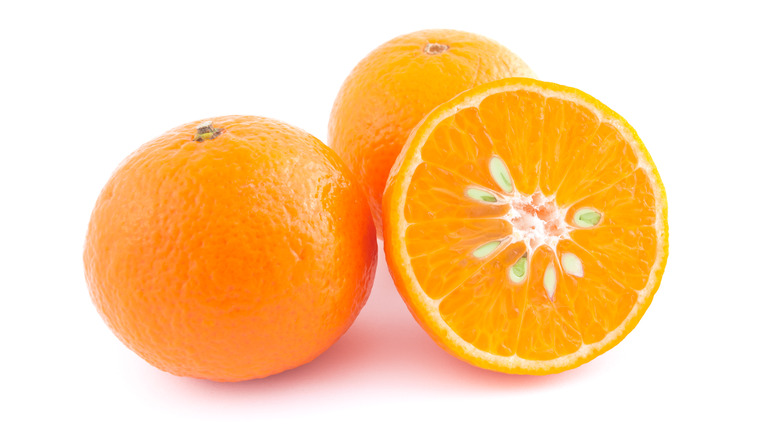The Most Common Types Of Oranges You'll Find Growing In Florida
Befitting its title as the Sunshine State, Florida's sunny climate has made it an ideal place for orange trees to grow. Even though citrus trees aren't indigenous to North America, Florida offers all the elements needed for the crop to flourish: subtropical temperatures, a lot of rainfall, and a sandy soil that allows the water to drain properly. Farmers have been growing oranges in the state since these fruits were first brought to the U.S. in the late 15th century. However, the Great Florida Freeze of 1835 eradicated citrus farming in northern Florida, as well as in Georgia and South Carolina.
Two more freezes that occurred in December 1894 and February 1895 further prompted the industry to move to southern Florida permanently. Today, Florida is one of the country's largest citrus producers, yielding 45.1 million boxes of oranges between 2021 and 2022 (per the Florida Department of Agriculture). However, you'll rarely see local Florida stores selling homegrown oranges. Ninety percent of the state's yield is used for processing everything from frozen and canned orange juice to citrus by-products, and the fruits that are sold in retail markets mostly come from California.
Getting to try a Florida-grown orange would require looking for roadside stores and farmer's markets in the state where the remaining 10% get sent. It is a worthy endeavor, however. Florida grows around 150 varieties of oranges and the four most popular types among them are prized for their sweet, juicy flesh. They are navel, Valencia, Hamlin, and pineapple oranges.
Navel oranges
Named after its belly button-like feature, navel oranges are ranked as the most popular orange variety. Easy to peel despite their medium-to-thick rind, they have a glossy, slightly pebbled peel. Navel oranges can have between 10 to 12 sections and they're known for their sweet and tangy flavor that's become the standard for orange juice. Their navel-like feature is actually an undeveloped second fruit that's a result of genetic mutation. The halted development of a "twin" fruit inside is also the reason why these oranges are seedless.
Navel orange trees are propagated through cutting and grafting, and their original source tree is found in Brazil. They were first introduced to the U.S. when the U.S. Department of Agriculture (USDA) brought back seedlings from South America in the 1870s. Navel oranges are great for adding to fresh salads since you don't have to worry about removing the seeds. They're also good for making orange-based marinades and sauces, especially when the recipe doesn't call for a specific type. You can use both the juice and zest to bake citrus-flavored goods.
However, when it comes to commercial juicing, navel oranges aren't the best choice due to their limonin, a compound that causes the juice to develop a bitter taste after getting exposed to oxygen for a few hours. You can still extract the juice for drinking at home as long as you plan to consume it immediately. When cooking with it, make sure to prepare the juice no longer than 30 minutes before it gets added to a dish. Navel oranges are available from November to June.
Valencia oranges
Referred to as "juice oranges," Valencia oranges have the perfect balance of sweetness and tartness. Their flesh is also tender and juicy, making them ideal for commercial juicing — especially since they contain little to no limonin. Their sections also contain very few seeds and they have a thin peel that's golden orange in color. However, since Valencia oranges are available from March to September, that means they ripen under the warmer weather of summer.
Exposure to heat and sunlight triggers the chlorophyll in the fruit's skin, which explains why these oranges sometimes develop green patches on their peel. This reaction doesn't affect their flavor, though. The skin also contains glands that store the fruit's fragrant oils, which is why you'll find their peel to have a leathery texture. These fruits are named after the coastal city of Valencia in Spain, which is also known as "The Orchard of Spain." In Florida, they make up ⅔ of the state's total citrus crop.
Because of their balanced flavor, Valencia oranges are great for eating raw. You can also separate the sections of the fruit to use as toppings for desserts, and they're perfect for making drinks and dressings since their juice doesn't turn bitter. Their flavor also complements pork so make your next marinade for pork chops or ham glaze with Valencia orange juice. Release the fragrant oils in the peel, too, by zesting them over pastries and other sweet treats. You can also dehydrate slices of this fruit and dip them in dark chocolate.
Hamlin oranges
Another popular Florida-grown orange that's used for juicing is the Hamlin orange. It is named after A. G. Hamlin, the owner of an orchard in Glenwood, Florida, where a chance seedling of this variety was planted in 1879. It has a sweet and slightly tart flavor but is low in acidity. Hamlin oranges are smaller than both navel and Valencia oranges, with a thin rind and a smooth peel with very fine pits.
They also ripen earlier, with their harvest season starting in October and lasting until January at the latest. This fruit generally contains up to six seeds, although some may be seedless. Their juicy flesh and delicious flavor have made Hamlin oranges a worthy substitute for Valencia oranges, especially since the latter takes longer to ripen. However, most people find Valencia oranges to still produce better-quality juice in terms of sweetness and color. That shouldn't dissuade you from enjoying Hamlin oranges, though.
Eat them raw as snacks, use them to make OJ in the morning, and add their juice to your marinades and sauces to brighten them up. The fact that this type of orange is one of the most cold-tolerant ones is a good reason to appreciate it since oranges usually only flourish in warmer weather. When your favorite varieties aren't in season yet, Hamlin oranges can provide you that citrusy flavor you crave, along with a burst of vitamin C.
Pineapple oranges
You won't be the only one to get excited over the idea of a hybrid fruit between a pineapple and an orange, but that's not what this Florida-grown produce is. Pineapple oranges, which are sometimes referred to as pineapple sweet oranges, grow and ripen from November to early January, making them a mid-season fruit. This variety is believed to have originated from a seed that was planted in Sparr, Florida, after 1860. The fruit was originally named "Hickory," but because of its rich, sweet flavor and delicate scent, it was renamed "pineapple orange" around 1883.
Pineapple oranges have a finely pitted reddish-orange peel, a medium-to-thick rind, and tender flesh. Each orange typically contains anywhere between 15 to 25 seeds. Seedless varieties of the pineapple orange exist, though. One of them is the U.S. Seedless Pineapple, the development of which started in 1970, according to the USDA. By 1983, the variety had advanced enough to allow its propagation in a commercial grove in Osceola County, Florida.
Pineapple oranges rose in popularity after the freezes that had occurred from 1894 to 1895, especially with their appearance and their excellent flavor that's great for processing into juice. However, this type of orange isn't a cold-resistant one. Ripened fruits also tend to drop from the tree and they're susceptible to pitting due to stress. Despite these issues, pineapple oranges remain one of Florida's most popular citrus crops. Excellent for snacking, their juice can also be used for making drinks, salad dressings, and sauces.
